
Megascolecidae is a family of earthworms native to Madagascar, Australia, New Zealand, Asia, and North America. All species of the Megascolecidae belong to the Clitellata class. The Megascolecidae comprise a large family of earthworms and they can grow up to 2 meters in length. The intercontinental distribution of Megascolecidae species favours the continental drift theory.

Leiognathidae, the ponyfishes, slipmouths or slimys / slimies, are a small family of fishes in the order Perciformes. They inhabit marine and brackish waters in the Indian and West Pacific Oceans. They can be used in the preparation of bagoong.

Eunicidae is a family of marine polychaetes. The family comprises marine annelids distributed in diverse benthic habitats across Oceania, Europe, South America, North America, Asia and Africa. The Eunicid anatomy typically consists of a pair of appendages near the mouth (mandibles) and complex sets of muscular structures on the head (maxillae) in an eversible pharynx. One of the most conspicuous of the eunicids is the giant, dark-purple, iridescent "Bobbit worm", a bristle worm found at low tide under boulders on southern Australian shores. Its robust, muscular body can be as long as 2 m. Eunicidae jaws are known from as far back as Ordovician sediments. Cultural tradition surrounds Palola worm reproductive cycles in the South Pacific Islands. Eunicidae are economically valuable as bait in both recreational and commercial fishing. Commercial bait-farming of Eunicidae can have adverse ecological impacts. Bait-farming can deplete worm and associated fauna population numbers, damage local intertidal environments and introduce alien species to local aquatic ecosystems.

Arhynchobdellida, the proboscisless leeches, are a monophyletic order of leeches. They are defined by the lack of the protrusible proboscis that defines their sister taxon, the Rhynchobdellida. Arhynchobdellida is a diverse order, compromising both aquatic and terrestrial, besides sanguivorous and predatory, leeches. The order is divided into two suborders, Erpobdelliformes and Hirudiniformes.

Hesionidae are a family of phyllodocid "bristle worms". They are marine organisms. Most are found on the continental shelf; Hesiocaeca methanicola is found on methane ice, where it feeds on bacterial biofilms.

Dodecaceria is a genus of marine polychaete worms in the family Cirratulidae. It's also one of the very few polychaete genera with a verified fossil record.

Lepidasthenia is a genus of marine Polychaete worms belonging to the family Polynoidae. Species of Lepidasthenia are found worldwide to depths of about 1200 m but are more common in shallower water.
Octurothrips is a genus of thrips in the family Phlaeothripidae, first described by Hermann Priesner in 1931. There is just one species in this genus: Octurothrips pulcher.

Flabelligeridae is a family of polychaete worms, known as bristle-cage worms, notable for their cephalic cage: long slender chaetae forming a fan-like arrangement surrounding the eversible head. Unlike many polychaetes, they also have large, pigmented, complex eyes.

Siphonostomites hesionoides is a species of polychaete annelid known only from subtidal lagoon deposits from the Early Eocene of Monte Bolca, Verona, Italy.

Lamprolina is an Australian genus of leaf beetles (Chrysomelidae) found in Victoria, New South Wales, and Queensland.
Bathynoe is a genus of marine annelids in the family Polynoidae. The genus includes two species, both known from depths of about 5000 m.
Myanophis is a genus of snake in the family Homalopsidae that contains the sole species Myanophis thanlyinensis. It is endemic to Myanmar, and was described in 2021 from two male and two female specimens found in the vicinity of the campus of East Yangon University.
Miyakella is a genus of shrimps belonging to the family Squillidae. It is a replacement name for Miyakea Manning, 1995 which was pre-occupied.
Sternaspis is a genus of annelids belonging to the family Sternaspidae.

Buskiella is a genus of pelagic polychaete annelids placed either in the family Flotidae or Flabelligeridae. In appearance, they are generally bluish or yellowish, depending on lighting conditions, and live exclusively in very deep water. They move by swinging their bodies from side to side, "rowing with [their] bristles." Species have nine to eleven chaetigers.

Flotidae is a family of pelagic polychaete worms, sometimes synonymized with Flabelligeridae, which they closely resemble. Other sources consider them the sister taxon to Flabelligeridae and closely allied to the latter group.

Flabelligera is a genus of polychaetes in the family Flabelligeridae. Species are common around the world, in both temperate and cold waters. Flabelligera species have long, club-like papillae, which are encased in a smooth mucus sheath. They also have a distinct cephalic cage, and hooked neurochaeatae which they use to hold onto rocks.











